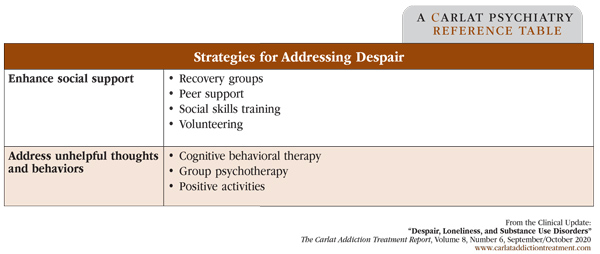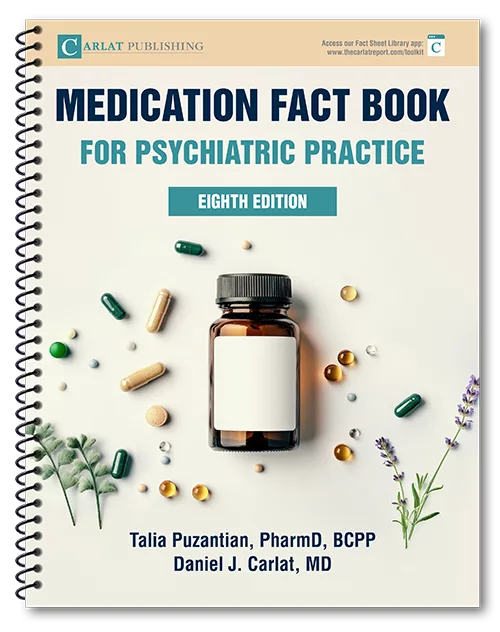Home » Despair, Loneliness, and Substance Use Disorders
CLINICAL UPDATE
Despair, Loneliness, and Substance Use Disorders
October 21, 2020
From The Carlat Addiction Treatment Report
Rehan Aziz, MD.
Associate Professor of Psychiatry and Neurology, Rutgers Robert Wood Johnson Medical School.
Dr. Aziz has disclosed that he has no relevant financial or other interests in any commercial companies pertaining to this educational activity.
Despair and loneliness are underappreciated contributors to substance use disorders (SUD). Their impact can be seen particularly in rural areas hit hard by industrial restructuring and poverty. This article will explore the interplay between despair, loneliness, and SUD and will review some strategies to use in your patients.
Hardship
From 1999 to 2015, US death rates declined by 8% because of advances in treatments for HIV, cardiovascular disease, and cancer. However, in rural adults, death rates increased by 6% over that same time period. This alarming rise is thought to be from increased suicides, poisonings, and liver disease—so-called deaths of despair (Stein EM et al, Am J Public Health 2017;107(10):1541–1547).
Two potential sources of despair in rural America have been economic hardship and job loss. To study this further, researchers looked at automotive assembly plant closures from 1999 to 2016. Closings were primarily in the US South and Midwest and were observed in 29 out of 112 counties studied. Five years after a plant closure, mortality rates had increased by 8.6 opioid overdose deaths per 100,000 individuals in counties with closures compared to those without closures. This represented an 85% jump relative to the mortality rate of 12 deaths per 100,000 in unimpacted counties. The largest rises were observed in white men aged 18 to 65 years (Venkataramani AS et al, JAMA Intern Med 2020;180(2):254–262).
Another study looked at job losses due to changing trade patterns that have shifted jobs overseas. These losses have disproportionately impacted rural counties in Appalachia. From 1999 through 2015, over 300,000 Americans died from opioid overdoses, with the highest per capita death rates in rural Appalachia. During this same period, over 2 million workers lost their jobs due to international trade, again with Appalachia experiencing the highest concentration of job losses. Researchers looked at Appalachian county-level data from this time period and found that for every 1,000 jobs lost, there was a 2.3% increase in opioid overdose deaths. When fentanyl was in the local heroin supply, that number rose to 11.3% (Dean A and Kimmel S, SSM Popul Health 2019;8:100409).
Despair
Are despair and death linked? To answer this question, investigators followed a population-based cohort in rural Appalachia from 1992 to 2015. A total of 1,420 subjects participated. Researchers measured despair by using portions of structured psychiatric interviews that captured features of despair: loneliness, hopelessness, helplessness, feeling unloved, low self-esteem, frequent worries, and feeling sorry for oneself. The authors found that high despair scores were associated with increased suicidal thoughts/behaviors and SUD. These findings occurred independently of any depressive disorders or sociodemographic factors (Copeland WE et al, JAMA Network Open 2020;3(6):e208627). See table “Strategies for Addressing Despair.”
Loneliness
People with SUD are particularly lonely, with loneliness prevalence rates ranging from 35% to 79% (Ingram I et al, Drug Alcohol Rev 2020;39(5):484–494). A recent cross-sectional study assessed loneliness and non-prescribed opioid use in 82 patients taking buprenorphine in an urban community health center. Investigators found that higher loneliness scores, which were measured by Version 3 of the UCLA Loneliness Scale, predicted the use of non-prescribed opioids. In fact, patients with the highest loneliness scores were all using additional opioids (McDonagh J et al, J Addict Med 2020 Feb 7;Epub ahead of print).
Interventions
Despair and loneliness may work synergistically, in patients dealing with economic shocks, to contribute to SUD and early death. The initial step is to provide appropriate care for any mood disorder, anxiety, and SUD. Keep in mind that despair may exist apart from depression. After the initial step, there are 2 strategies for despair and loneliness: 1) enhance social support and 2) address unhelpful thoughts and behaviors. Approaches are summarized in the table below.
The goal in enhancing social support is to help patients identify and pursue meaningful relationships that support recovery. Examples include encouraging patients to attend recovery groups, engage in peer support activities, or do volunteer work. Some patients will benefit from social skills training, which can teach them how to interact effectively with others.
Many patients who are lonely or despairing may have negative thoughts and behaviors. The goal for therapy is to help patients develop authentic relationships, a sense of purpose, ability to confide in others, comfort with vulnerability, and reduced social isolation. Key treatment targets are thoughts related to mistrust of others, lack of perceived support, low self-worth, and fear of negative judgment.
Lastly, clinicians should encourage positive activities by having patients re-engage in leisure pursuits, participate in organized religious or social groups, read books, listen to music, and engage in physical activity, as appropriate (Ingram et al, 2020).
CATR Verdict: Despair, loneliness, and economic hardship are important contributors to addiction incidence and its poor outcomes. This has been studied especially in middle-aged men living in rural areas and in low-income urban areas. Clinicians can combat despair and loneliness by using psychotherapeutic interventions that enhance social support.
Clinical UpdateHardship
From 1999 to 2015, US death rates declined by 8% because of advances in treatments for HIV, cardiovascular disease, and cancer. However, in rural adults, death rates increased by 6% over that same time period. This alarming rise is thought to be from increased suicides, poisonings, and liver disease—so-called deaths of despair (Stein EM et al, Am J Public Health 2017;107(10):1541–1547).
Two potential sources of despair in rural America have been economic hardship and job loss. To study this further, researchers looked at automotive assembly plant closures from 1999 to 2016. Closings were primarily in the US South and Midwest and were observed in 29 out of 112 counties studied. Five years after a plant closure, mortality rates had increased by 8.6 opioid overdose deaths per 100,000 individuals in counties with closures compared to those without closures. This represented an 85% jump relative to the mortality rate of 12 deaths per 100,000 in unimpacted counties. The largest rises were observed in white men aged 18 to 65 years (Venkataramani AS et al, JAMA Intern Med 2020;180(2):254–262).
Another study looked at job losses due to changing trade patterns that have shifted jobs overseas. These losses have disproportionately impacted rural counties in Appalachia. From 1999 through 2015, over 300,000 Americans died from opioid overdoses, with the highest per capita death rates in rural Appalachia. During this same period, over 2 million workers lost their jobs due to international trade, again with Appalachia experiencing the highest concentration of job losses. Researchers looked at Appalachian county-level data from this time period and found that for every 1,000 jobs lost, there was a 2.3% increase in opioid overdose deaths. When fentanyl was in the local heroin supply, that number rose to 11.3% (Dean A and Kimmel S, SSM Popul Health 2019;8:100409).
Despair
Are despair and death linked? To answer this question, investigators followed a population-based cohort in rural Appalachia from 1992 to 2015. A total of 1,420 subjects participated. Researchers measured despair by using portions of structured psychiatric interviews that captured features of despair: loneliness, hopelessness, helplessness, feeling unloved, low self-esteem, frequent worries, and feeling sorry for oneself. The authors found that high despair scores were associated with increased suicidal thoughts/behaviors and SUD. These findings occurred independently of any depressive disorders or sociodemographic factors (Copeland WE et al, JAMA Network Open 2020;3(6):e208627). See table “Strategies for Addressing Despair.”
Loneliness
People with SUD are particularly lonely, with loneliness prevalence rates ranging from 35% to 79% (Ingram I et al, Drug Alcohol Rev 2020;39(5):484–494). A recent cross-sectional study assessed loneliness and non-prescribed opioid use in 82 patients taking buprenorphine in an urban community health center. Investigators found that higher loneliness scores, which were measured by Version 3 of the UCLA Loneliness Scale, predicted the use of non-prescribed opioids. In fact, patients with the highest loneliness scores were all using additional opioids (McDonagh J et al, J Addict Med 2020 Feb 7;Epub ahead of print).
Interventions
Despair and loneliness may work synergistically, in patients dealing with economic shocks, to contribute to SUD and early death. The initial step is to provide appropriate care for any mood disorder, anxiety, and SUD. Keep in mind that despair may exist apart from depression. After the initial step, there are 2 strategies for despair and loneliness: 1) enhance social support and 2) address unhelpful thoughts and behaviors. Approaches are summarized in the table below.
Table: Strategies for Addressing Despair
(Click to view full-sized PDF.)
The goal in enhancing social support is to help patients identify and pursue meaningful relationships that support recovery. Examples include encouraging patients to attend recovery groups, engage in peer support activities, or do volunteer work. Some patients will benefit from social skills training, which can teach them how to interact effectively with others.
Many patients who are lonely or despairing may have negative thoughts and behaviors. The goal for therapy is to help patients develop authentic relationships, a sense of purpose, ability to confide in others, comfort with vulnerability, and reduced social isolation. Key treatment targets are thoughts related to mistrust of others, lack of perceived support, low self-worth, and fear of negative judgment.
Lastly, clinicians should encourage positive activities by having patients re-engage in leisure pursuits, participate in organized religious or social groups, read books, listen to music, and engage in physical activity, as appropriate (Ingram et al, 2020).
CATR Verdict: Despair, loneliness, and economic hardship are important contributors to addiction incidence and its poor outcomes. This has been studied especially in middle-aged men living in rural areas and in low-income urban areas. Clinicians can combat despair and loneliness by using psychotherapeutic interventions that enhance social support.
KEYWORDS addiction alcohol alcohol-use-disorder opioid-use-disorder opioids relationships special populations treatment
Issue Date: October 21, 2020
Table Of Contents
Recommended
Newsletters
Please see our Terms and Conditions, Privacy Policy, Subscription Agreement, Use of Cookies, and Hardware/Software Requirements to view our website.
© 2025 Carlat Publishing, LLC and Affiliates, All Rights Reserved.



_-The-Breakthrough-Antipsychotic-That-Could-Change-Everything.webp?t=1729528747)



